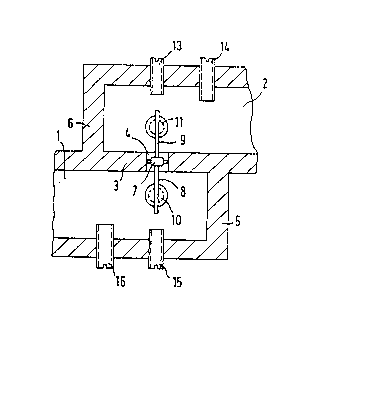Une partie des informations de ce site Web a été fournie par des sources externes. Le gouvernement du Canada n'assume aucune responsabilité concernant la précision, l'actualité ou la fiabilité des informations fournies par les sources externes. Les utilisateurs qui désirent employer cette information devraient consulter directement la source des informations. Le contenu fourni par les sources externes n'est pas assujetti aux exigences sur les langues officielles, la protection des renseignements personnels et l'accessibilité.
L'apparition de différences dans le texte et l'image des Revendications et de l'Abrégé dépend du moment auquel le document est publié. Les textes des Revendications et de l'Abrégé sont affichés :
| (12) Brevet: | (11) CA 1263457 |
|---|---|
| (21) Numéro de la demande: | 1263457 |
| (54) Titre français: | AGENCEMENT POUR L'ACCOUPLEMENT ENTRE GUIDES D'ONDES CREUX ET UN COMPOSANT SEMICONDUCTEUR |
| (54) Titre anglais: | ARRANGEMENT FOR COUPLING HOLLOW WAVEGUIDES TO A SEMICONDUCTOR COMPONENT |
| Statut: | Périmé et au-delà du délai pour l’annulation |
| (51) Classification internationale des brevets (CIB): |
|
|---|---|
| (72) Inventeurs : |
|
| (73) Titulaires : |
|
| (71) Demandeurs : |
|
| (74) Agent: | SMART & BIGGAR LP |
| (74) Co-agent: | |
| (45) Délivré: | 1989-11-28 |
| (22) Date de dépôt: | 1987-02-03 |
| Licence disponible: | S.O. |
| Cédé au domaine public: | S.O. |
| (25) Langue des documents déposés: | Anglais |
| Traité de coopération en matière de brevets (PCT): | Non |
|---|
| (30) Données de priorité de la demande: | ||||||
|---|---|---|---|---|---|---|
|
ABSTRACT OF THE DISCLOSURE
An arrangement for coupling waveguide modes between two
waveguides via a semiconductor element. The two waveguides
each have a short-circuiting end wall and a common side wall
constituting a common partition wall between the waveguides
so that the two waveguides extend parallel to, and overlap
one another at least over a partial length where they are
separated from one another by the common side wall. The
common partition wall is provided with a coupling aperture
and the semiconductor element is inserted into the coupling
aperture between the two waveguides and is in ground contact
with the common partition wall. The semiconductor element
has two connecting arms, one connecting arm extending as a
coupling probe into one of the waveguides and the other
connecting arm extending as a coupling probe into the other
waveguide.
Note : Les revendications sont présentées dans la langue officielle dans laquelle elles ont été soumises.
Note : Les descriptions sont présentées dans la langue officielle dans laquelle elles ont été soumises.

2024-08-01 : Dans le cadre de la transition vers les Brevets de nouvelle génération (BNG), la base de données sur les brevets canadiens (BDBC) contient désormais un Historique d'événement plus détaillé, qui reproduit le Journal des événements de notre nouvelle solution interne.
Veuillez noter que les événements débutant par « Inactive : » se réfèrent à des événements qui ne sont plus utilisés dans notre nouvelle solution interne.
Pour une meilleure compréhension de l'état de la demande ou brevet qui figure sur cette page, la rubrique Mise en garde , et les descriptions de Brevet , Historique d'événement , Taxes périodiques et Historique des paiements devraient être consultées.
| Description | Date |
|---|---|
| Le délai pour l'annulation est expiré | 1997-11-28 |
| Lettre envoyée | 1996-11-28 |
| Accordé par délivrance | 1989-11-28 |
Il n'y a pas d'historique d'abandonnement
Les titulaires actuels et antérieures au dossier sont affichés en ordre alphabétique.
| Titulaires actuels au dossier |
|---|
| ANT NACHRICHTENTECHNIK G.M.B.H. |
| Titulaires antérieures au dossier |
|---|
| MICHAEL ALBERTY |
| WALTER GROSS |